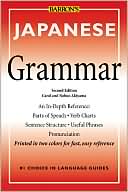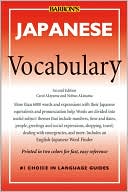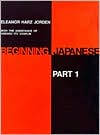Japanese the Manga Way: An Illustrated Guide to Grammar and Structure
Japanese difficult? Study boring? No way! Not with this “real manga, real Japanese” approach to learning. Presenting all spoken Japanese as a variation of three basic sentence types, Japanese the Manga Way shows how to build complex constructions step by step. Every grammar point is illustrated by an actual manga published in Japan to show how the language is used in real life, an approach that is entertaining and memorable. As an introduction, as a jump-start for struggling students, or...
Search in google:
A "real manga, real Japanese" study guide and resource for language students and teachers School Library Journal Gr 10 Up-In concise, meticulous prose, Lammers intends to teach absolute beginners how to use manga to learn to speak and read conversational Japanese. This seems like a daunting task, and it is, but for someone who has the patience, drive, and desire to learn the language, the book will be an immense help. The author's primary method for teaching it is to present a panel or scene from a manga (a list of the manga used is included in an appendix), then offer a four-tier translation of what the character is saying. Beneath the written Japanese is the romaji ("Roman letters") text, then comes a word-for-word translation so nonnative speakers can understand the structure of the Japanese, and finally a polished translation that expresses what the sentence means in natural English. Between these panels and translations (which take up the bulk of each page) are detailed explanations of the grammar, pronunciation, and sentence structure of each example. Although Lammers suggests that this book will be useful for beginners, he presents information in such a fast-paced way that readers will best be served by using the book as a supplement to a language class. No exercises are included, but the author does recommend specific titles for the purpose of self-testing. This volume will be useful for libraries in schools in which Japanese is taught as well as public libraries serving college-bound patrons.-Steev Baker, Kewaskum Public Library, WI Copyright 2005 Reed Business Information.
\ School Library JournalGr 10 Up-In concise, meticulous prose, Lammers intends to teach absolute beginners how to use manga to learn to speak and read conversational Japanese. This seems like a daunting task, and it is, but for someone who has the patience, drive, and desire to learn the language, the book will be an immense help. The author's primary method for teaching it is to present a panel or scene from a manga (a list of the manga used is included in an appendix), then offer a four-tier translation of what the character is saying. Beneath the written Japanese is the romaji ("Roman letters") text, then comes a word-for-word translation so nonnative speakers can understand the structure of the Japanese, and finally a polished translation that expresses what the sentence means in natural English. Between these panels and translations (which take up the bulk of each page) are detailed explanations of the grammar, pronunciation, and sentence structure of each example. Although Lammers suggests that this book will be useful for beginners, he presents information in such a fast-paced way that readers will best be served by using the book as a supplement to a language class. No exercises are included, but the author does recommend specific titles for the purpose of self-testing. This volume will be useful for libraries in schools in which Japanese is taught as well as public libraries serving college-bound patrons.-Steev Baker, Kewaskum Public Library, WI Copyright 2005 Reed Business Information.\ \







